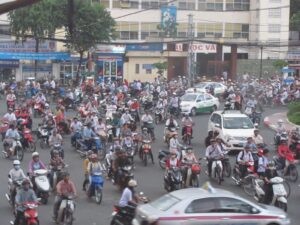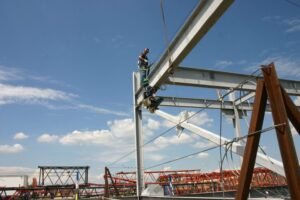
On a recent business trip to Vietnam to deliver some rigging training for a client, I got to witness firsthand the motorcycle chaos on the streets of Ho Chi Minh city. If you’ve never seen it, pull up a YouTube video of motorcycles in Ho Chi Minh city. When you first arrive and are immersed in this traffic, it is a white-knuckle experience. My commute every morning was thirty minutes of close calls between our car and the multitudes of motorbikes zooming around us, missing our bumper by a mere couple of inches. I think the hardest thing for me to wrap my head around, was the fact that there weren’t any traffic signs and very few discernable traffic patterns. It was a literal free for all with motorbikes driving the wrong way down sidewalks to get around cars. Yet I never saw one accident in the week I was there. When I talked to my driver, he told me that accidents were actually very rare. How could this be possible?
As safety professionals, we always want to have everything fit into our nice, neat little safety rules. If worker does X than eventually Y will happen. The problem is, most of us are jaded, we’ve seen folks, good people with children and families, get severely injured and even killed. When these things happen, it is very easy to default to be the Monday morning quarterback, “well if worker X would have just followed this rule then this would not have happened.” And the truth is, we are almost always right. If the employee follows all the rules and prioritizes his or her safety above all other things, then worker X does not get hurt 90% of the time. The problem is, this thinking is flawed. We are human, we do not run on simple if/then statements. We have the ability to reason and assign a temporary risk rating to every given situation. The problem with this is, humans make mistakes and the acceptable risk level is different for everyone.
Want proof? I am a second-generation Ironworker, since I was 15 years old, I was going to work sites with my father and walking steel. Granted my father never let me get above the first floor while I was younger and was always holding onto the back of my britches while walking right behind me. My whole career, there were very few beams that I wouldn’t walk across, no matter how high. I love heights, I loved the freedom of getting above all the noise and chaos so that it was just my connecting partner and myself having fun, doing good hard work. I am not fearless when it comes to heights though, quite to the contrary. If you ever drive by the ole McClure Clan house around Xmas, you’ll never see Xmas lights on the upper parts of our roof. Why you ask? Because I am scared to death to get on the edge of our steep roofs and put those lights out. Pretty funny huh? Big tough Ironworker wont even get on the edge of his roof to hang Xmas lights because he is afraid, he is going to roll off. If you ever meet me in person this will make more sense, you see, I am round and built to roll! It’s not the roofs height that scares me, it’s the situation and the different risk assessment I assigned to each situation.
The Herd Protects The Herd
So, if all humans have different risk assessments, what stops them from getting hurt when they also do not have rules and procedures in place to follow and keep them in line? From my experience, it’s the herd.
I recently was watching a Discovery channel show on elephants about how they protected each other. A key factor in a herd’s survival rate was the age and number of older matriarchs in the herd. In her article “What elephants can teach us about the importance of female leadership” Lesley Evans Ogdens says, “Matriarchs carry with them a trove of crucial information. They have a unique influence over group decision-making. And, like human leaders, the most successful may even possess certain personality traits.” Two major factors play into an elephant herds mortality rate, the age and life experiences of the matriarchs leading the herd, and the herds unwavering commitment to protect the weaker, less experienced members of the herd. Ed Yong describes this in his blog “Older elephants know the best anti-lion moves”. Ed says, “When lions hunt elephants, they usually target youngsters or females, and they almost always attack from behind. They circle round a straggler, jump onto its back and flanks (out of the way of the trunk), and drag it to the ground. They never go for a frontal assault, so elephants can thwart their attacks by bunching together. The calves go in the middle; the adults face outwards in a formidable defensive ring of tusks and trunks.
Herd Safety At Construction Sites
I’ve seen this same herd phenomena played out on construction sites. I’ve recently consulted to a group building the largest sport stadium in the US. The project team was concerned about having any injuries on such a high-profile project, so they would fly me in twice a month to conduct a site audit and deliver training to their employees. After reviewing all their policies and procedures I was astonished that they had such a good safety record. Their safety policies were very few when compared to some of my other clients on much smaller projects. But after spending time in the field with the employees, it was clear what was going on:
A. This project had attracted some of the best and most experienced construction workers from around the United States to come work on it.
B. Most of these workers traveled in their groups that they had always worked with, or their herd.

“In a time when we have fewer young people entering the trades than are retiring from it, it has never been more important to pass on those life experiences or we will find ourselves in a safety crisis.”
I would watch daily as they looked out for each other, older workers would tell the younger guys, “hey, there’s gonna be rain today, be careful walking that steel, it’s gonna be slick.” I watched as one more experienced worker, physically moved another from walking beside a large crawler crane, “those track pins can shear off, if they come out, they’ll go right through you.” The herd was protecting the herd.
Do not misunderstand me, I am not advocating for dispensing all the safety rules and policies. I firmly believe that every rule was put in place for a reason. It reminds me when I was a child going to the bathroom next to my father and reading the sticker on the urinal, “do not eat urinal cake”. I said “Dad, why would they put a sticker that says that?” His reply, “because son, every time you see one of these weird rules, that means that at some point in time, someone did something to require that rule.” Humans are weird, we all have different values and risk assessment values! In addition to implementing good safety policies and procedures, we also need to focus on training our people. But just training them is not good enough, they need training from folks who have life experiences that they can pass on to the younger generation to enhance the safety of the herd. In a time when we have fewer young people entering the trades than are retiring from it, it has never been more important to pass on those life experiences or we will find ourselves in a safety crisis. There are not enough rules or safety policies in the world to protect someone from hazards that they have never heard of, hazards that don’t fit neatly in our safety rules.
In an elephant herd the bigger more experienced elephants protect the smaller more inexperienced ones. In Vietnam my driver explained to me that if a car hits a motorbike, it is always considered the driver of the cars fault and the penalty for doing so is very stiff. I also witnessed whole families riding to school and work on the same motorbike, (my record was four family members on one bike). I witnessed many children obviously younger than 10 years old driving motorbikes on the streets. The correlation? The older /bigger members of the herd (the automobiles) were forced to look out for the younger, weaker members of the herd (the motorbikes) and experience was accumulated from a very early age driving the motorbikes, a recipe for success, the herd safety phenomena.
Author: Bryan McClure

No comment yet, add your voice below!